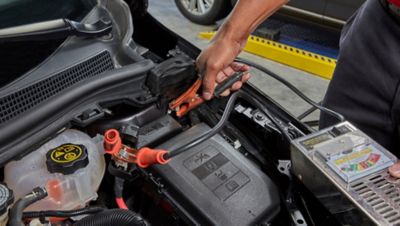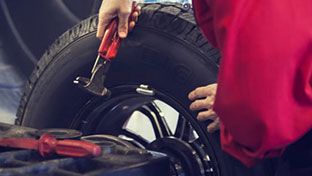Your car is filthy, and it's about to rain. A tempting time to let Mother Nature take care of the dirty work, but even a light drizzle can leave damaging deposits. Better break out the bucket and soap instead.

- Why Wash: Rain rinses away dirt and dust, but it also leaves behind acidic deposits that can take a toll on the exposed parts of your car. This means that your car actually needs to be washed more frequently during rainy times to protect your paint job and any metallic finishes, like chrome.
- When To Wash: It's best to wash your car every 7-10 days with car shampoo. Remember to how to wash your wheels, where grime and water spots easily collect.
If your car has been out in the rain and you don't have time for a full wash, you can neutralize the rain's acidity with a quick hose down. Keep in mind that hard water can also leave behind a residue, so it's best to make time for at least a semi-regular scrub.
- Wash Tips: Always use a car shampoo. Unlike regular soap or other detergents, car shampoo contains a lubricant that protects soft paint from scrubbing scratches. When you wash, use a soft cloth or non-abrasive sponge. After all, you're not cleaning last night's lasagna pan.
WAXING WISDOM
In addition to frequent washing, your car needs to be waxed regularly to maintain a protective barrier against the elements.
- When To Wax: It's best to wax your car at least four times a year, ideally at the beginning of each season. If your car is black, white or red, it's smart to wax again mid-season since these colors are more sensitive to acid rain and UV rays.
- Wax Tips: When it comes to car wax, you get what you pay for—so choose your product wisely. Better products will give you better, longer lasting protection, but a cheap wax is better than no wax at all.
Keep in mind that water droplets act like tiny magnifying glasses when the sun's rays hit them. So give the hood, the roof and the trunk a little extra TLC, since they are the most vulnerable to intense UV rays because they are flat surfaces that don't easily allow water to roll off.
ASSESSING YOUR ACCESSORIES
Now that your car is cleaned and waxed, it's time to check out all those exposed parts and pieces that help get you safely where you're going.
- Tires: A wet-weather trip requires more grip than normal. Check your tires to be sure you have enough tread to grip wet roads. Not sure how to tell? Learn how to do a one-minute tire inspection.
- Wiper Blades & Fluid: A streaky windshield is not safe, particularly in a downpour. Make a thorough inspection of your wiper blades part of your wet-weather car care routine.
Next, take a look under the hood at your wiper fluid levels. The fluid well is a transparent, plastic tank with blue fluid inside. The cap will read "Wiper Fluid Only" or something to that effect, and show an image of a windshield with fluid tracks. Locate the fill line, and then add washer fluid up to that line.
- Headlights and Taillights: Over time, filmy residue can build up on headlights and taillights, so spend a little extra time on these important areas when washing your car. Keep a check on the bulbs, too. Remember, it's the law in most states to have your headlights on if it's rainy, foggy or after dusk. During a dark drive, it will be easier to tell when a headlight goes out than a taillight, so don't overlook either one.
Better yet, visit any of our stores for a free inspection.
During wet weather, your car has a thankless job of keeping you dry and comfortable. Follow these wet-weather car care tips, and your car will be thanking you.

